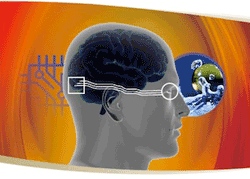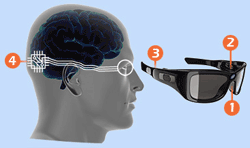Group to test direct-to-brain bionic eye on human patients
Novel approach from team out of Australia has led to unprecedented success in developing field
A group of electrical engineers and doctors at the Monash Vision Group, part of Australia’s Monash University, are looking to test out their direct-to-brain bionic eye on human patients by 2014.

The Monash Vision Group has a unique approach to creating a next-gen bionic eye.
The team believes that their solution will effectively provide vision to nearly 85% of those declared clinically blind. This is important because there’s already close to 300 million visually impaired people in the world, so research into how to restore vision for this growing group has long since passed the critical point.
Technology in this field has seen gradual improvement in recent years, but the doctors at MVG believe they are standing at the precipice of the most expansive and far-reaching solution yet, one that could serve as the foundation for permanently repairing human vision moving forward.
Brief history
Bionic eyes are nothing new — they’ve actually been around for quite some time. In fact, most recently two blind British men were successfully fitted with electronic retinas. As part of a clinical trial, they were fitted with a wafer-thin 3-mm-square microelectronic chip that came with 1,500 light-sensitive pixels. The purpose of the chip was to function as the eye’s photoreceptor rods and cones. The surgery took place behind the retina, and involved the placement of a fine cable that ran to a control unit under the skin behind the ear.

X-ray showing position of chip with cable running to control unit. (Via: bbc.co.uk)
Advancements like the one just described certainly seem promising, but they do have some limitations:
• If the optic nerves are damaged, retinal stimulation cannot send visual signals to the brain
• People with partial vision loss risk losing vision in all regions of their eye as a result of the surgical procedure
• While spatial resolution is possible with retinal stimulation, it is limited in the central mascular region of vision
To address these issues, the team is taking the very unorthodox approach of bypassing surgery on the damaged eye.
The direct-to-brain bionic eye
This is what makes the MVG’s approach so unique: The doctors are completely bypassing the complexities that come with trying to reconstruct the complexities of the human eye. Instead, what they’ve developed is a pair of glasses that have tiny, high-resolution cameras in them to serve as the eye’s retina. Video recorded by these cameras is sent to a pocket-worn digital processing unit that converts the camera’s recorded video into electrical signals which, in turn, get sent to a microchip implanted directly on the surface of the patient’s visual cortex (located in the back the brain).
More specifically, specially written algorithms transform the camera’s image data to a pattern that gets wirelessly transmitted to the micro-sized electrodes on the brain implant chip. Upon receiving these signals, the chip responds with the appropriate voltage, current, and timing to stimulate an image within the visual cortex of the brain.
The results right now are rudimentary, black-and-white images, but many believe that this is the start of a very promising, alternative approach to providing sight to the visually impaired.

Illustration details how the direct-to-brain bionic eye works.
Professor Arthur Lowery, Director of MVG, explains: “The aim for this vision prosthetic is to be at least equivalent to a seeing-eye dog or a white cane.”
He adds, “While it would initially complement existing aids such as these, we believe the device eventually will replace them, and as the technology is further refined, become sufficiently sensitive to discriminate large print.”
What if parts of a patient’s eye still work?
This is an interesting topic to take up when it comes to the bionic eye. You see, most patients gradually lose sight in some areas of their visual field and not others. Since MVG’s approach does not require actual, physical surgery of the eye, any existing sight that still remains will be retained, and actually complemented by the direct-to-brain bionic eye.
Who can use this technology?
MVG hopes to develop the direct-to-brain bionic eye to the point where it can be used by people of all ages and with all vision impairments, including those with acquired retinal, optic nerve, or ocular disease, as well patients with an intact visual cortex, and more.
In terms of patients gradually losing their sight due to the effects of aging, the team has designed the technology to enable continual external adjustment by a clinician. This means that as a patient’s eyesight continues to decline, the direct-to-bionic eye can be adjusted so that it is more heavily relied upon.
Outlook
MVG will now begin to document the exact effectiveness of restored sight with the direct-to-brain bionic eye via continued research and other development programs. The doctors plan to move forward with testing the technology on live patients by the year 2014.
You can follow their progress via the Monash Vision Group website. ■
Advertisement
Learn more about Electronic Products Magazine





